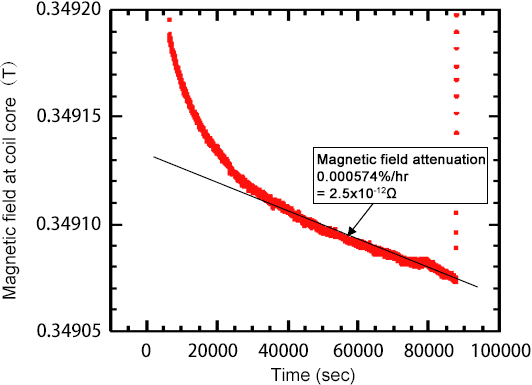Development of Persistent Current Technology Using Rare Earth Superconducting Wire Materials
- Progress toward realization of MRI magnets using HTS wire materials -
Furukawa Electric Co., Ltd. (hereinafter Furukawa Electric, President Mitsuyoshi Shibata) and the Institute for Materials Research, Tohoku University (hereinafter Tohoku University, Professor Kazuo Watanabe) have successfully developed superconducting connection technology and an HTS persistent current switch with a resistance of around 10-12 (10 to the 12th power) Ω by connecting with rare earth superconducting wire materials. This research and development has been carried out with a view to realizing medical devices applying HTS wire materials, and with the support of the Ministry of Economy, Trade and Industry’s “project to develop basic technologies for HTS coils” and the Japan Agency for Medical Research and Development’s (AMED) “R&D on fundamental technologies of high-stability magnetic field coil systems in medical device and system R&D project to realize future medical care”.
Outline of development results
- We achieved a 10-12 Ω connection with rare earth superconducting wire materials(note 1) and realized a previously impossible superconducting connection of HTS wire materials.
- We connected a superconducting coil and persistent current switch(note 2) using rare earth HTS wire materials and achieved a persistent current operation(note 3) of 100A at 20K, and verified a persistent current operation that maintained a magnetic field of 3,500 Gauss for 10 hours.
R&D details
At present, superconducting MRI scanners(note 4) use a superconducting coil made from metallic superconductive wire and cooled with liquid helium to an ultralow temperature (minus 269 ℃). By making a closed circuit containing several such superconducting metallic coils and persistent current switches connected by superconductive wires, we have produced a persistent current maintaining a constant magnetic field for a long time (more than one year) with no external current supply. By obtaining a stable high magnetic field with low running power, producing a persistent current has promoted the broader use of MRI in medical practice.
Since HTS wires enable superconductivity at liquid nitrogen temperature (minus 196 ℃), they show promise in MRI scanners that would not use helium, a scarce resource, and the AMED project has been conducting the development of an MRI coil using rare earth HTS wire materials. Rare earth superconducting wires do not facilitate persistent current operation because they do not enable superconductive connections, and so a continuous electrical current flow from a power supply was always required. To obtain clear images, a special high-stability power supply also had to be developed.
Furukawa Electric has produced a test superconducting coil and a persistent current switch using the rare earth HTS wire materials of SuperPower Inc., a subsidiary of Furukawa Electric in the U.S., and connected them with superconductors to manufacture a superconducting coil device. At Tohoku University, researchers cooled this superconducting coil device to 20 K (minus 250℃) using a compact refrigerating machine before applying a 100 A current from a power source with the persistent current switch in the open position to generate a magnetic field of 3,500 Gauss. They then closed the persistent current switch to isolate the device from the external power source and verified that a current of 100 A flowed for more than 24 hours. When magnetic field attenuation had stabilized, they verified from 10 hours of magnetic field attenuation measurements that the superconducting connection had a of 10-12 Ω connection resistance.
Future plans
At Furukawa Electric, we will continue working on the development of persistent current technology based on the results of this technical development, such as lowering resistance by improving the critical current of superconducting connections. The development of persistent current technology is expected to contribute toward the realization of devices based on high-temperature superconducting (HTS) wire materials other than MRI scanners, such as nuclear magnetic resonators (NMR) and superconducting levitation devices.

Glossary
(note 1)Rare earth HTS wire materials
These are sperconducting wire materials that form an intermediate layer on a tape-shaped metallic substrate, and are formed as a film by the crystalline orientation of an oxide superconductor layer made from rare-earth elements (yttrium, gadolinium etc.), barium, copper, and others. Entering a superconducting state at liquid nitrogen temperature (minus 196 ℃), they are the highest performing materials among HTS wire materials in practical use, with a high current density and low property degradation even within a magnetic field.
(note 2)Persistent current switch
This is a switch device that, by varying the temperature of a superconducting coil with a heater and thereby switching it between a state of superconductivity and a state of normal conductivity, uses the differences in resistance to turn on or off.
(note 3)Persistent current operation
When both ends of a superconducting coil made from zero-electrical resistance superconducting wire are placed in a closed circuit that is closed with a persistent current switch, a current continues to flow without attenuation. This is called a persistent current, and ordinary MRI coils are run by persistent current operation. Until now, HTS coils were not operable by a persistent current because superconducting connection with HTS wire materials was not possible, and so they always needed a continuous current flow from a power source.
(note 4)Superconducting MRI (magnetic resonance imaging) scanner
This is a device that can obtain cross-sectional images of the human body using strong magnetic field and electromagnetic waves, and has become an essential item of medical equipment in diagnostic pathology. Currently operated MRI scanners generate a magnetic field using a superconducting coil made of a metallic superconducting wire material such as NbTi wire that has been cooled to the temperature of liquid helium (minus 269 ℃). Furukawa Electric has long produced metallic superconducting wire materials for MRI coils and has an extensive supply track record.
About Furukawa Electric Group
Furukawa Electric (TSE; 5801, ISIN; JP3827200001) Group started business in 1884, when its copper-smelting facility and wire manufacturing factory was established. Since then Furukawa Electric has become pioneers in the latest technologies by addressing diverse technological issues. Furukawa Electric has released products in a number of areas, including telecommunications, electronics, automobiles, and construction, with the three types of materials it works with at their core, namely, optics, plastics, and metals. Many of these products have attained the top global market share, and all of its products have contributed to society in numerous business areas. Furukawa Electric reported consolidated revenues of JPY 867.8 billion (approximately USD 8.2B) for the fiscal year ended March 31, 2015.







 Share
Share Tweet
Tweet Share
Share